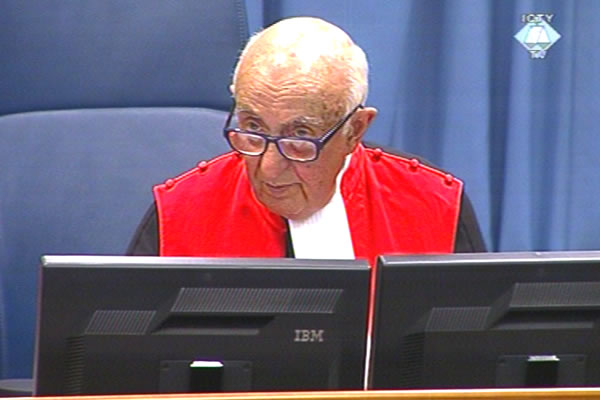Home
GENOCIDE CHARGE AGAINST KARADZIC REINSTATED
As his case continues, Radovan Karadzic will have to answer the charges in Count 1 of the indictment against him, for the genocide in Bratunac, Foca, Kljuc, Prijedor, Sanski Most, Vlasenica and Zvornik, the Tribunal’s Appeal Chamber had decided
 Theodor Meron, president of the Tribunal
Theodor Meron, president of the Tribunal Judge Theodor Meron’s Appeals Chamber today granted in part the prosecution’s appeal and reversed the acquittal on Count 1 in the indictment against Radovan Karadzic. The former Republika Srpska president was charged with genocide in seven municipalities in BH – Bratunac, Foca, Kljuc, Prijedor, Sanski Most, Vlasenica and Zvornik.
In June 2012, the Trial Chamber led by the Korean judge O-Gon Kwon acquitted Karadzic at the half-time of the trial of the genocide in the municipalities. The Trial Chamber found that the crimes underlying the charge: killings, serious bodily and mental harm, forcible transfer of the population and imposing inhumane conditions of life, did not in their ‘nature, scope and context reach the scale’ that would allow a conclusion beyond reasonable doubt that they were committed with the intent to annihilate in part or entirely Bosnian Muslims and/ or Croats as an ethnic or religious group.
According to Judge Meron, the Appeals Chamber analyzed the Trial Chamber’s judgment to verify if there was enough evidence which ‘could’ lead a reasonable trier of the facts to conclude that Karadzic was guilty of the genocide in the municipalities. The charges did not have to be ‘proven’ beyond reasonable doubt. In light of that fact, the Appeals Chamber ruled that there was evidence showing that the crimes underlying the genocide charge: killings, serious bodily or mental harm, imposing inhumane conditions in prison facilities were indeed committed, and that Karadzic and other members in the joint criminal enterprise did have genocidal intent.
In the judgment summary, Judge Meron reminded of the killings, rapes and suffering of the detainees in Omarska, Keraterm, Foca, Betonirka and other prison facilities in the municipalities in question. The prisoners were beaten, sometimes for days, with rifles, rifle butts, batons, sticks, chains, metal pipes, rods, pieces of furniture. They sustained serious bodily and mental trauma as a result.
The Appeals Chamber also contends that the evidence called by the prosecution to prove that Karadzic had the intent to commit genocide was convincing: ‘[t]he Appeals Chamber notes that the Trial Chamber received evidence that in meetings with Karadžić “it had been decided that one third of Muslims would be killed, one third would be converted to the Orthodox religion and a third will leave on their own” and thus all Muslims would disappear from Bosnia’. The judges recalled that at the appellate hearing Karadzic’s legal advisor accepted that the statement could be proof of genocidal intent.
The evidence indicates that other high-ranking Serb leaders, who are also alleged to be members of the same joint criminal enterprise, shared the genocidal intent. Judge Meron recalled that when the former VRS Main Staff commander Ratko Mladic spoke about Croats and Muslims, he said, “[m]y concern is to have them vanish completely’. Judge Meron also recalled that, according to Slobodan Milosevic, Momcilo Krajisnik ‘wanted to kill off all Muslims and Croats’.
Apart from the now reinstated Count 1, charging him with genocide in the municipalities, Karadzic faces charges in ten more counts in the indictment: for the genocide in Srebrenica, the ethnic cleansing of large parts of BH, artillery and sniper terror campaign in Sarajevo and using UN staff as human shields.
Linked Reports
- Case : Karadzic
- 2013-07-10 WHAT ‘GOD-FEARING’ PRESIDENT KNEW ABOUT SREBRENICA
- 2013-07-09 KARADZIC RECYCLES KRAJISNIK’S FAILED ARGUMENT
- 2013-07-08 ‘AMBIENT CONDITIONS’ CAUSED NON-SERBS TO EVACUATE
- 2013-07-16 IDIOTS THAT ORDERED ATTACK ON SREBRENICA
- 2013-07-16 KARADZIC WANTS TO SEVER COUNT 1
- 2013-07-17 EXPERT WITNESS DENIES CRIMES IN BH
